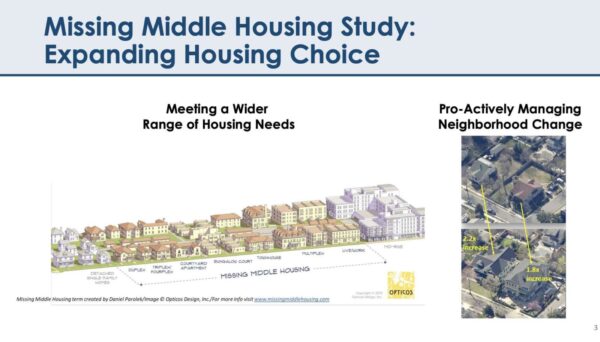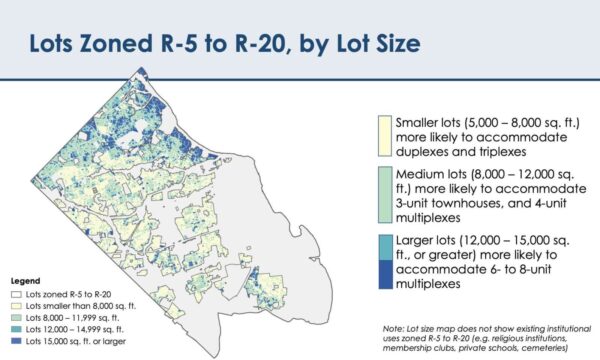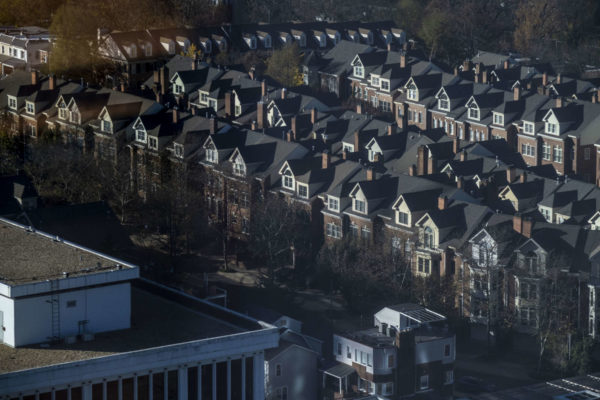
(Updated at 4:25 p.m.) The draft plan to allow more small-scale multifamily housing in Arlington has picked up another influential enforcement.
The county’s Missing Middle Housing Study draft framework recommends allowing everything from townhouses to an eight-unit apartment or condo buildings on land currently zoned exclusively for single-family detached homes. The lot size would determine the maximum number of units and the structure would be no bigger than what’s currently allowed by-right as a single-family home.
Following an endorsement by the Arlington branch of the NAACP two weeks ago, the framework — which is still under discussion and would require County Board action later this year to go into effect — has now picked up the support of the Potomac River Group chapter of the environmental organization.
In a letter to the County Board, the group says building more housing closer to jobs helps prevent sprawl and pollution from longer commutes.
The Sierra Club supports the Missing Middle Housing Study Phase 2 Draft Framework and urges its adoption by the County Board. This letter outlines the rationale for our support.
Adding missing middle housing to existing low-density development is an antidote to suburban sprawl. It results in far more compact and energy efficient housing located closer to jobs, transit, goods and services. It results in sharply reduced greenhouse gas emissions from both buildings and transportation when compared to housing developed in the outer suburbs, or to the enormous single-family homes typically erected in place of smaller homes in Arlington.
The environmental destruction caused by suburban sprawl also is well-documented. Entire ecosystems are bulldozed to create homes far from jobs. The environmental destruction caused by adding missing middle housing, in contrast, is minimal, as each multi-unit building will be no larger than the size already allowed for a single-family home.
Not every Sierra Club member is on board, however. Long-time civic activist Suzanne Smith Sundburg wrote an email to the group in response to the “missing middle” endorsement calling its leaders “shameless, green-washing political hacks.”
“That is the kindest description I can offer,” she wrote. “[The] group has now endorsed an upzoning plan in Arlington County that will reduce the tree canopy replacement requirement by half.”
“The Sierra Club’s endorsement of paving over the last bit of Arlington that isn’t already paved — with an 8-fold increase in housing density and the loss of half of our remaining tree canopy — has left many Arlingtonians speechless,” Sundburg added.
Her remarks were echoed by other “local environmentalists” she quoted and identified only by first name, as well as by several local residents on the Nextdoor social network, where debates over missing middle housing have been raging since ARLnow first reported on the framework.

The Sierra Club, however, pushed back on the critics and refuted their assertions of significant tree canopy loss as “unsubstantiated.”
From the Sierra Club chapter’s letter:
Some have used environmental arguments in opposition to multi-unit housing. One concern often raised is that multi-unit housing will result in added stormwater runoff. The County’s stormwater challenges are very real and are worsened by climate change. However, the Missing Middle Framework is clear that any new buildings will be limited to the size already allowed, making the proposal essentially neutral in terms of impact on stormwater. It is up to the County, with community support, to ensure that new construction of all kinds does not contribute in any way to Arlington’s stormwater problems, which are caused primarily by poor practices of the past.
Some people say that existing single-family-only zoning laws are good for the environment because they effectively direct population growth away from Arlington. The Sierra Club disagrees. The Club judges that the best way to minimize negative environmental effects from the projected increase of 75 million in the U.S. population by 2060 is to build more densely in already developed areas, rather than encourage sprawling, low-density development on undeveloped land. Planning for this inevitable growth in population, as Arlington is doing, is the best and most responsible way to protect the climate and promote environmental sustainability.
Another common concern is that multi-unit housing will harm Arlington’s tree canopy. In fact, some have made unsubstantiated claims that the Framework will result in the “potential devastation” of Arlington’s tree canopy. The basis for this devastation, they say, is that state law allows developers of multi-unit housing to meet a lower standard of 15 percent tree canopy coverage on their lots rather than the single-family-housing standard of 20 percent. On closer inspection, however, these numbers bear little relationship to reality. The 15 and 20 percent numbers represent the expected growth of canopy twenty years into the future, based on trees on the lot at the time of initial occupancy, including saplings planted by the developer. As soon as an occupancy permit is issued, all trees on a property may be removed or neglected; there is no requirement for any owner to meet the canopy coverage ratios. Our understanding is that there can be no such requirement under Virginia state law.
The Sierra Club believes the best way to increase tree canopy in Arlington is to promote stronger state and local policies that will create effective incentives for all property owners, including multi-unit owners, to plant and maintain more trees. The Club also supports EcoAction Arlington’s Tree Canopy Equity Program, which targets tree planting in areas where trees are most needed, and the Civic Federation’s initiative to preserve Arlington’s tree canopy.
The county-organized group studying missing middle housing, meanwhile, believes that only about 20 current single-family lots per year would becoming multifamily if the framework was adopted.
Contrary to the study’s suggestion that allowing more housing types would provide more modestly-priced homes for more people, at least relative to the current cycle of tearing down older homes in order to build single-family large homes at higher price points, Sundburg and other missing middle critics also assert that that the plan will do nothing to create more affordable housing.
“It should be noted that this upzoning plan will produce NO affordable housing (for anyone but the truly wealthy), will further inflate land values (and tax bills), and will displace existing fixed-, lower- and middle-income residents,” she wrote.

The Sierra Club and the NAACP, however, both said their support is at least partially based on missing middle creating more housing opportunities, particularly for those who cannot currently afford a single-family home.
From the club’s letter:
There are important equity and justice issues involved in this policy decision. There is a long history in Arlington of excluding those who cannot afford the cost of a single-family home from living within about 70 percent of the County’s land area, including many of the most scenic and desirable areas close to parks, transportation, top-ranked schools and other amenities. This exclusion is accomplished by the County’s single-family-only zoning law. While this currently operates as a form of economic exclusion, in the not-too-distant past explicit race-based provisions were included in many neighborhoods. While many contend that the currently practiced economic exclusion is benign, we believe the evidence strongly supports our view that it is a factor in the ongoing disparities that exist in our community. As land prices in Arlington climb ever higher, the unfairness of exclusive zoning laws only grows.
Sundburg — and other missing middle critics like the group Arlingtonians for Our Sustainable Future (ASF) — claim the opposite is true.
“Make no mistake: upzoning=gentrification,” Sundburg wrote. “Call it anything you like, but no historic wrong will be corrected by this latest upzoning scheme.”
“For almost 20 years, developers have been looking to crack on the last bit of buildable land in Arlington,” she continued, “And now at long last, using racial justice as a pretext, they and their REIT investors/speculators will profit at the expense of the degrading of the air we breathe and the water we drink. Skyrocketing tax bills (a direct consequence of increasing the land’s ‘development potential’) will drive up the cost of housing for all Arlingtonians, and it will displace the dwindling number of Black neighbors still residing in Arlington’s historic African American communities.”
ASF made a similar assertion in a five-page analysis of the draft framework.
These new MM units will NOT BE AFFORDABLE TO households earning below $108,000. This includes the majority of African-American (average income of $66,781) and Latinx (average income of 86,513) households in Arlington. These residents, and not the minority populations of the DMV, are the proper targets for our housing policy, but they are left out.
(The NAACP, in its letter to the Board, said “the proposed zoning changes could result in additional housing attainable to up to 39% of Black households, 39% of Latino households, and 60% of Asian households in the Washington metro area, according to county staff analysis.”)
The Sierra Club letter addressed another hot topic among the critics — parking — saying that street parking in existing single-family home neighborhoods is “readily available” and new missing middle housing should “rely, to the maximum extent possible, on street parking rather than requiring on-site parking spaces that increase impervious surface area.”
The letter concluded:
The Framework will not, by itself, resolve the affordable housing crisis in Arlington that requires so many local workers to commute from elsewhere. However, any multi-unit housing provided under the Framework will almost certainly be less expensive than the very large single-family houses that will be built under current zoning. Adoption of the Framework would make Arlington a national leader on housing policy and a more sustainable community for decades to come.
The Arlington County Board is scheduled to hold a work session on the Missing Middle Housing Study on July 12, which will likely be followed by a vote on whether to continue to a third phase of the study, which will focus on implementation of the recommendations.
The Board would then likely vote on on implementing the recommended zoning changes in the fall.
Dan Adams, Director of Policy and Communication for the Arlington County Board, issued the following statement to ARLnow Thursday afternoon about what’s next for the missing middle study.
The next step for the County Board is a work session on July 12 with county staff. The work session is intended to provide the Board with a current briefing on the draft framework, present a summary of the feedback from community engagement to date, and receive guidance on how to proceed with Phase 3 of the MMHS. Consistent with the already advertised timeline, there will be no codifying actions taken until later in the fall at the earliest.
The County Board recognizes that this is a complex issue that requires significant thought and consideration. It engenders a broad range of viewpoints among Arlingtonians, therefore community input on the framework is still being collected in a variety of ways, including online comment form, direct correspondence with the community, and stakeholder meetings.
We invite community members to continue sharing their thoughts so that staff may compile the feedback and present it at the July 12 work session. Opportunities for providing feedback will remain throughout Phase 3 of the process.

